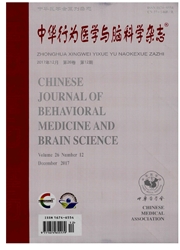

 中文摘要:
中文摘要:
目的探讨静脉移植骨髓问充质干细胞(BMMSC)治疗酒精性痴呆模型鼠(AAD)的疗效及其机制。方法采用全骨髓贴壁法分离培养大鼠BMMSC并进行流式细胞鉴定。通过持续28d酒精灌胃(20%,8ml/kg)建立AAD大鼠模型,经尾静脉途径将DAPI标记的BMMSC移植至大鼠体内,观察其在海马中的定位,并以Morris水迷宫行为学、海马组织形态和神经细胞凋亡检测作为疗效评价标准。采用免疫组化检测大鼠海马区脑源性神经营养因子(BDNF)阳性细胞的表达以及比色法检测大鼠血清总超氧化物歧化酶(T—SOD)和谷胱甘肽过氧化物酶(GSH.Px)的变化。结果BMMSC高表达CD29、CD90,低表达CD34、CD45,移植后可迁移至大鼠海马区。与PBS组相比,BMMSC移植后大鼠的逃避潜伏期时问明显缩短[(10.17±0.71)S,(4.71±0.34)s,P〈0.01],且其海马形态结构破坏及神经细胞凋亡明显改善[(72.67±2.73),(55.5±5.14),P〈0.05]。免疫组化结果显示,与PBS组相比,BMMSC组大鼠海马区BDNF的表达显著增高[(71.54±13.71),(135.25±22.20),P〈0.05]。氧化应激检测证实,与PBS组相比,BMMSC组大鼠血清GSH.Px酶活力显著增高[(526.89±62.73)VS.(2592.75±243.73),P〈0.01],但T—SOD酶活力无明显改变。结论BMMSC移植可改善AAD大鼠学习记忆功能及修复海马组织损伤,其机制可能与促进海马组织BDNF表达及抗氧化应激有关。
 英文摘要:
英文摘要:
Objective To observe therapeutic benefits of intravenously transplanted bone marrow mesen- chymal stem cells (BMMSCs) on alcohol-associated dementia (AAD) rat model and study its underlying mecha- nisms. Methods BMMSCs were isolated by the method of differential adhesion and membrane antigens were de- tected with flowcytometric analysis. To establish AAD model, SD rats were intragastricly administrated with ethanol (20% ,8 ml/kg) for 28 days. Then BMMSCs were labeled with DAPI and injected into the blood via caudal vein. And animals were evaluated by observing Morris Maze behavior, hippocampal morphology and neuronal apoptosis. The expression of BDNF was detected by the method of immunohistochemistry. And the activities of total superox- ide dismutase (T-SOD) and glutathione peroxidase (GSH-Px) in rat blood serum were also measured. Results The results of flowcytometry analysis indicated BMMSCs were CD29, CD90-positive, and CD45, CD34- negative. And the cells labeled with DAPI were observed in rat hippocampus 3 days after intravenous injection. Compared with PBS group,the escape latency of rats in BMMSC group was apparently shortened( (10.17 ±0.71 ) s vs. (4.71 ±0.34)s, P〈0.01 ). And the morphological structure was repaired and neuronal apoptosis was re- duced in rat hippocampus after BMMSC transplanting( (72.67 ± 2.73) vs. (55.5 ± 5.14), P 〈 0.05 ). Immuno- histochemical results showed that the expression of BDNF was significantly increased in the hippocampus of rats in BMMSC group ( (71.54 ± 13.71 ) vs. ( 135.25 ± 22.20), P 〈 0.05 ). Also, the activity of GSH-Px was apparently improved in the blood serum of rats treated with BMMSC transplanting ( ( 526.89 ± 62.73 ) vs. ( 2592.75 ± 243.73 ), P 〈 0.01 ), but no change for that of T-SOD. Conclusion The results provide a novel therapeutic strategy for improving learning and memory function and reducing hippocampal damage induced by ethanol administration,which is closely related to
 同期刊论文项目
同期刊论文项目
 同项目期刊论文
同项目期刊论文
 期刊信息
期刊信息
